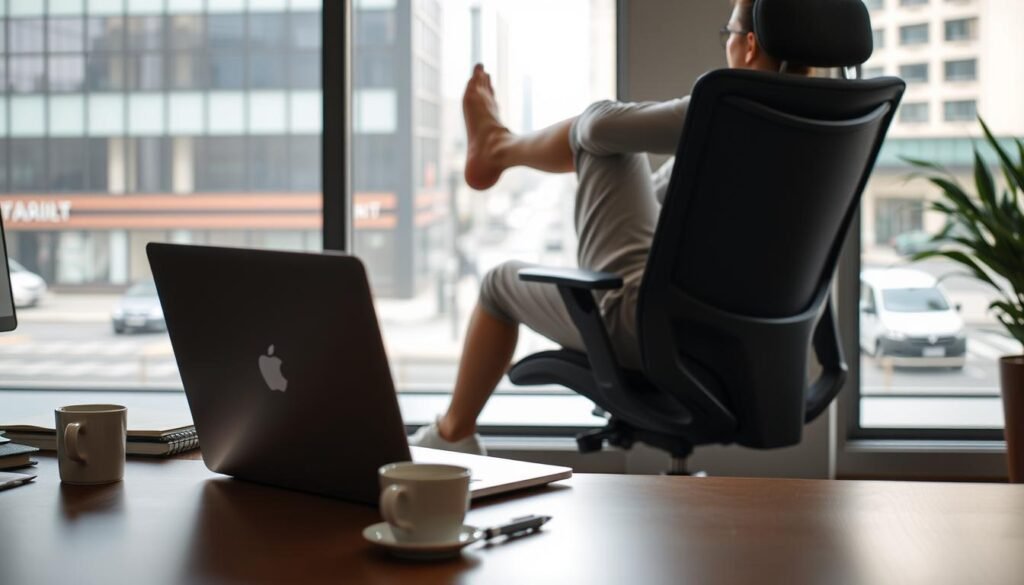Did you know that 8 in 10 American workers spend their day in sedentary jobs? Sitting for long hours can lead to discomfort in your neck and back, impacting both your health and productivity. But what if you could find relief without leaving your workstation?
A sedentary lifestyle is linked to serious health risks, including thousands of annual deaths. The good news? Simple desk stretches can make a big difference. In just 10 minutes, you can reduce pain, improve posture, and boost your focus.
We’ve combined ergonomic wisdom with practical support to create a routine that fits seamlessly into your busy schedule. Ready to transform your day? Let’s get started.
Key Takeaways
- 80% of American workers have sedentary jobs, leading to discomfort.
- A 10-minute routine can provide relief without leaving your workstation.
- Sedentary lifestyles are linked to serious health risks.
- Simple stretches reduce pain, improve posture, and enhance productivity.
- This routine combines ergonomic wisdom with practical support.
Why Desk Stretches Are Essential for Your Health
The modern workplace is a breeding ground for health risks linked to inactivity. Over the past 50 years, desk-bound jobs have surged, leaving workers vulnerable to musculoskeletal issues. A stiff neck can trigger tension in your back, creating a chain reaction that affects your entire body.
According to a BMJ study, sedentary work increases the risk of cardiovascular diseases and diabetes. Stretching at your workstation can reduce these dangers. Research shows that workplace stretching can lower pain by up to 72%, making it a simple yet powerful solution.
One critical concept to understand is the “cold muscle” effect. When you stretch without warming up, your muscles are more prone to injury. This is especially important for remote workers, who face a 30% increase in home office-related complaints.
Incorporating stretches into your routine is a cost-effective way to improve posture and prevent long-term damage. Unlike expensive ergonomic furniture, stretching requires minimal time and effort. It’s a small investment with significant returns for your health and productivity.
Top Benefits of Incorporating Desk Stretches into Your Routine
Small changes in your habits can lead to significant health improvements. Adding simple movements to your day can help you feel better, work smarter, and stay healthier. Let’s explore the key benefits of making this a regular practice.
Improved Posture and Flexibility
Slouching at your workstation can strain your spine and muscles. Simple exercises like seated spine twists counteract this by improving flexibility and alignment. Better posture reduces tension and keeps your body balanced throughout the day.
Reduced Risk of Chronic Pain
Regular movement can lower the risk of conditions like carpal tunnel syndrome by up to 40%. Engaging your muscles for 10-30 seconds at a time helps prevent stiffness and chronic pain. This keeps you comfortable and focused on your tasks.
Enhanced Productivity and Focus
Taking short breaks to move can boost your productivity by 15%. These microbreaks reset your mind, improving focus and efficiency. Plus, stretching intervals reduce stress and digital eye strain, keeping your eyes fresh and your mind sharp.
Incorporating these habits into your routine is a small step with big rewards. You’ll feel better, work smarter, and protect your long-term health.
Simple Desk Stretches for Neck Relief
Relieving neck tension can be as simple as a few targeted movements. Whether you’re working from home or in an office, these exercises can help you feel better in minutes. Let’s explore two effective techniques to ease discomfort and improve alignment.
Neck Retraction Exercise
This exercise helps correct forward head posture, a common issue for desk workers. Start by sitting upright and gently tuck your chin toward your chest. Imagine pushing the back of your head into an invisible wall. Hold this position for 5 seconds, then release. Repeat this hourly to maintain proper alignment.
Upper Trapezius Stretch
This stretch targets the muscles connecting your neck and shoulder. Begin by tilting your head to one side, bringing your ear toward your shoulder. For a deeper stretch, rotate your chin slightly toward your armpit. Hold for 10-15 seconds, then switch sides. Avoid tucking your chin too far during rotations to prevent strain.
For added support, use the back of your chair to stabilize your movements. If you experience persistent pain, consult a professional to ensure you’re performing these stretches safely. These small adjustments can make a big difference in your comfort and focus.
Effective Desk Stretches for Back Pain
Back pain is a common issue for many office workers, but relief is within reach. Simple movements using your chair can ease tension and improve your spinal health. Let’s explore two effective techniques to target your back and enhance comfort.
Office Chair Back Stretch
This exercise focuses on your lumbar region. Sit upright and place your hands on the edge of your chair. Gently arch your back while pushing your chest forward. Hold for 30 seconds, then release. Repeat this five times to improve flexibility and reduce stiffness.
Seated Spine Twist
This stretch targets your spine and obliques. Sit with your feet flat on the floor. Cross one leg over the other and place the opposite hand on your knee. Exhale as you twist your torso, looking over your shoulder. Hold for 10-15 seconds, then switch sides. This movement helps engage deeper muscles and improves alignment.
These exercises are simple yet effective. Incorporate them into your routine to maintain a healthy back and boost your productivity. If you experience persistent discomfort, consult a professional to ensure proper technique.
Quick Stretches for Your Arms and Wrists
Your arms and wrists often bear the brunt of long hours at the keyboard. Over time, this can lead to stiffness, discomfort, and even conditions like carpal tunnel syndrome. The good news? A few simple movements can make a big difference.
We’ve compiled two effective techniques to help you relieve tension and improve flexibility. These exercises are easy to do and require no special equipment. Let’s dive in.
Seated Tricep Stretch
This stretch targets the back of your arm, where tension often builds. Start by raising one hand overhead and bending your elbow so your palm rests between your shoulder blades. Use your other hand to gently pull the elbow toward your head. Hold for 30 seconds, then switch sides. This movement helps release tightness in your triceps and improves mobility.
Wrist Flexion Stretch
For this stretch, extend one arm straight out in front of you with your palm facing up. Use your other hand to gently pull your fingers back toward your body. Hold for 15 seconds, then switch sides. This exercise helps alleviate tension in your forearm and wrist, making it ideal for those who type frequently.
Incorporate these movements into your routine to keep your arms and wrists feeling fresh and pain-free. Small adjustments can lead to big improvements in your comfort and productivity.
Desk Stretches to Loosen Up Your Legs
Your legs often feel the strain of long hours at your workstation, but relief is just a few movements away. Simple exercises can improve circulation, reduce stiffness, and keep you comfortable throughout the day. Let’s explore two effective techniques to target your calf and hamstring muscles.
Calf Raises
This exercise is perfect for improving blood flow in your legs. Stand up straight and lift your toes off the ground, raising your heels as high as possible. Lower them back down slowly. Aim for 20 reps during each standing break. This movement helps with venous return, keeping your calf muscles active and healthy.
Hamstring Chair Stretch
For this stretch, sit on the edge of your chair with one foot flat on the floor. Extend the other leg straight out, heel on the ground and toes pointing up. Lean forward slightly from your hip, feeling the stretch in your hamstring. Hold for 30 seconds, then switch sides. This exercise is great for relieving tension in your knee and upper leg.
Incorporating these movements into your routine can make a big difference. They’re quick, easy, and require no special equipment. Keep your legs feeling fresh and ready for whatever the day brings.
How to Make Desk Stretches a Daily Habit
Building a daily habit of movement can transform your workday. It’s not about finding extra time but integrating small actions into your existing routine. With a few simple strategies, you can make these practices second nature.
Start by pairing movements with common triggers. For example, every time your phone rings, take a moment to stretch. This technique, known as microhabit stacking, helps build consistency without overwhelming your schedule.
Consider using tools like the StretchClock app to set reminders. Research shows that hourly movement breaks can improve focus and reduce fatigue. Set a timer for every 30 minutes to remind yourself to stand, stretch, and reset.
Accountability can also make a big difference. Organize team stretch challenges at work to encourage collective participation. Tracking your progress with calendar checkmarks or a habit tracker provides visual motivation and keeps you on track.
Pair your movements with ergonomic tools like standing desks. Alternate between sitting and standing to keep your body engaged. Reward yourself with a post-stretch tea ritual or a favorite playlist to make the experience enjoyable.
By incorporating these strategies, you’ll create a sustainable habit that supports your health and productivity. Small steps lead to big changes, and consistency is the key to success.
Conclusion: Transform Your Workday with Desk Stretches
Taking just 10 minutes daily can transform your workday and boost your overall wellness. These small efforts add up, offering over 50 hours of annual prevention against discomfort and strain. Consistency is key to unlocking long-term relief and vitality.
Take inspiration from Mark, who reduced his migraines by 60% in just three weeks. His story shows how simple habits can lead to significant improvements. Join our community by sharing your stretch selfies and inspiring others to prioritize their health.
For professional guidance, download the OSHA guidelines PDF to ensure safe and effective practices. Remember, your chair is now your wellness tool. Start today and experience the benefits of a healthier, more energized workday.
FAQ
Why are desk stretches important for my health?
Desk stretches help combat the effects of a sedentary lifestyle by improving posture, reducing muscle tension, and lowering the risk of chronic pain. They also boost circulation and enhance focus during long work hours.
How often should I do desk stretches?
We recommend incorporating stretches into your routine every 1-2 hours. Even a few minutes of movement can make a significant difference in how your body feels throughout the day.
Can desk stretches help with back pain?
Yes, stretches like the seated spine twist and office chair back stretch can alleviate tension in your lower and upper back, promoting better spinal alignment and comfort.
What are some quick stretches for neck relief?
The neck retraction exercise and upper trapezius stretch are excellent for easing neck stiffness. These movements target tight muscles and improve flexibility in the neck and shoulders.
Are there stretches to help with wrist discomfort?
Absolutely. The wrist flexion stretch and seated tricep stretch can relieve tension in your arms and wrists, which is especially helpful for those who type or use a mouse frequently.
How can I make desk stretches a daily habit?
Set reminders on your phone or computer to take short breaks. Pair stretches with other habits, like after a meeting or during a coffee break, to make them a seamless part of your day.
Can desk stretches improve my productivity?
Yes, regular stretching boosts blood flow, reduces fatigue, and enhances mental clarity, helping you stay focused and efficient throughout your workday.








